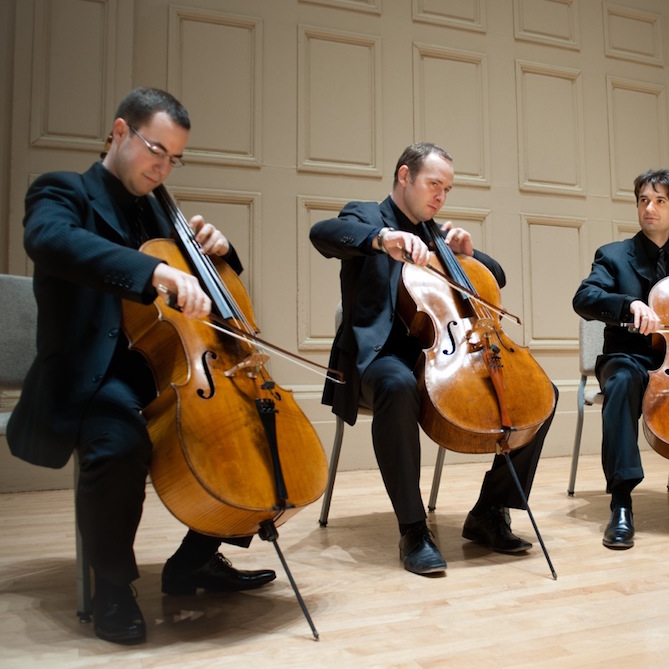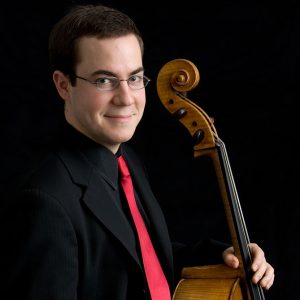
Backstage with the Boston Cello Quartet
Blaise Dejardin
A few weeks ago, I had a video conversation with my 4 years-old nephew and my brother on Skype. At one point, my brother (also a cellist) tells my nephew: “You know Blaise plays in a cello quartet? He plays with three other cellists.” My nephew starts laughing: “A cello quartet? Noooo…That’s not possible!”
Yes, it is! But it is indeed a strange concept and I believe it is rare to get a chance to have such a group with a long-term commitment. Since the Boston Cello Quartet is now releasing its first CD album, “Pictures”, it was interesting to look back on our three years together and talk about the challenges of being in a cello quartet.
When I asked my colleagues to form a cello quartet, I knew we had several things going for us. Not only were we likely to stay in the BSO for a while, but being in the same orchestra already gave us a natural inclination to have similar styles.
We had our first rehearsal in January of 2010 and read through tons of music, most of it given to us by fellow cellists. Our goal was to put together a program for a Prelude concert at Tanglewood the following summer. Prelude concerts are one-hour-long chamber music concerts given by the members of the BSO before every Friday concert at Tanglewood. It is safe to say that this first concert was probably the most nerve-racking experience of our life as performers. We were not there playing a typical chamber music cello part but instead playing challenging high-pitched solos closer to what a violin part would be. All this at Ozawa Hall, in front of an audience which included many of our BSO colleagues and staff, very curious to know what we were about. Thankfully, the concert was a big success and we proved to ourselves that we were on the right track. So far, we have brought three different programs to Tanglewood, making an effort to constantly broaden our repertoire. And repertoire is always a challenge for a cello quartet.
When we first read through the piles of music our friends gave us, we encountered many compositions that just didn’t cut it for us. There was a tendency in the first half of the 20th Century to set the top voice in the most comfortable register for the cello, which is around the neck position on the A string. That meant all the other voices would be stuffed in the lower register of the cello, making the whole sound muddy and heavy. It was clear to us that a high first cello voice would be needed to allow the harmony to breathe and to make us sound more like a string quartet. The cello has an unbelievable range and it would be sad not to use it. Our first program included several arrangements by Douglas B.Moore, a Mozart sonata arranged by Valter Despalj, a version of Albinoni’s Adagio by Werner Thomas-Mifune, and I took out of my closet a medley I had written for a Cello Studio recital in Paris back in 2005. I also wrote an arrangement of Piazzolla’s “La Muerte del Angel” for the occasion. Throughout the years, I have been writing more and more for the BCQ, since it seemed the best way to have a repertoire unique to us.
Because the top voice is often very challenging, we decided from our very first rehearsal that we would be rotating chairs for every single piece. This makes it fun for everyone, since we all get a chance to be featured, and it also allows us to play a full concert of virtuoso music. To have one cellist playing all the top voices for one hour would be more exhausting than playing a concerto! Plus, the audience never fails to laugh at the sight of our game of musical chairs on stage.
Most of our concerts keep the format of the Tanglewood Prelude concerts, a full hour of music with no intermission. We strive to make it a fun experience, both for us and for the audience. Our programs usually start with a famous classical overture, and we finish with the non-classical pieces, such as jazz, tango or comic medleys. The final medley is the opportunity for us to just relax and have fun on stage, even if we try to keep playing in tune! We often add some stage comedy, either acting, choreography or extra instruments like a slide-flute or a harmonica. We talk to our audience regularly during the concert and always chat with them afterwards. We know many of them personally by now.
After three years together, I can say the dynamic of our group is close to a string quartet, but probably more relaxed, because we do this for fun and we don’t rely on it to make a living. Today I know my three partners better than anyone else in my orchestra, both as players and people. I realized at our first rehearsal that it was so much fun to hear them play as individuals. Even if we play together in the BSO, we are part of such a big group that we don’t really hear each other that well. Since we are before anything a chamber music group, we learned to play together just like any string quartet would. Sometimes it means matching our bow strokes, adjusting the volume of our sound, finding a way to keep the accompanying voices below the top voice while being exciting and supportive. When we played Arvo Part’s Fratres, which has a structure very much like a “hairpin”, one long crescendo followed by a long diminuendo, we tried to match our vibrato, starting senza vibrato and widening our vibrato on the way to the climax of the piece, then going back down to senza vibrato.
One of our most challenging pieces is my arrangement of four movements from Pictures at an Exhibition by Mussorgsky. Adam, who inherited the top voice, has to play very high on the fingerboard, almost up to the edge, and we had to find a way to sound large (like in “The Great Gate of Kiev”) without overpowering him.
Although our repertoire is challenging, it is probably a good part of the fun for us. We enjoy the challenge and we are all aware that we would probably be worse players today if it was not for the cello quartet! It is not every day that you get to play a challenging part in orchestra, and our cello quartet concerts keep us in shape. None of us wants to sound worse than our colleagues so everyone practices hard and it is for the better of the group. I also believe it is for the better of our cello section in the BSO. The more some of us play together, the better we will sound as a section. Since we are rotating seats in the orchestra, if we happen to all be seating next to each other, almost every time one of us will start playing a piece from our repertoire, as a little inside joke.
Since we wanted the other members of the cello section to experience some of the fun we have, we had our first concert with the Tanglewood Cello Ensemble last summer. Made up of the cellists from the BSO together with the cello students from the Tanglewood Music Center (a total of 24 cellists!), we played a 30 minute program, for the celebration of Tanglewood on Parade. Everyone had a great time and we hope to make it an annual tradition.
It is also our hope that we will be helping to change the concept some people have of classical music. In the summer of 2011, we got to play the first half of the show for the rock band “Train” at the Tanglewood Shed. We were a bit nervous about playing Rossini for a pop audience but they loved it, and we even joined Train on stage later for a couple of their songs. We also recorded the soundtrack for a videogame that same year. After a concert in Woods Hole, we had some kids coming backstage to have us sign some posters that they wanted to put on their bedroom wall. It was their first classical music concert and they couldn’t believe how exciting it was. Shortly after we founded the group, the son of a BSO colleague decided to found his own cello quartet within the Boston Youth Symphony Orchestra. This is the kind of inspiration we wish to give to the next generations.
I would like to finish with my favorite story so far. We had just played a concert for kids at Tanglewood and I was hurrying to the cafeteria to grab a quick bite before the BSO concert. As I was walking through the Tanglewood lawn, I heard a small voice calling me, and here was this 8-years-old girl running after me, with a huge smile across her face. “Thank you for the concert!”, she said. “Well, I am glad you liked it! Do you play the cello?” Behind her arrives her mother, breathless from running after her daughter from the concert hall. “No, she is a violinist” she says. “But you just convinced her that the cello is a great instrument so we are going to switch.”
That just made my day, if not my summer! To think that what we are doing will inspire future generations of cellists is really a treat. We hope to play many more years together, to show everyone how great the cello is and how much fun classical music can be.
Subjects: Artists
Tags: arrangements, backstage, Blaise, Boston, Boston Cello Quartet, Boston Symphony Orchestra, Boston Youth Symphony Orchestra, BSO, cello, cellobello, change of concept, classical music, comedy, compositions, concert, Dejardin, fun classical music, generations, jazz, making a living, musical comedy, musical styles, new arrangements, orchestra playing, orchestral musicians, Ozawa Hall, quartets, repertoire, rotating chairs, skype, strange concepts, structure, success, Tanglewood, Tanglewood Cello Ensemble, Tanglewood on Parade, Tanglewood Shed, tango, virtuosic music, virtuoso

